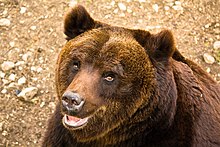| Marsican brown bear | |
|---|---|

| |
| Scientific classification | |
| Domain: | Eukaryota |
| Kingdom: | Animalia |
| Phylum: | Chordata |
| Class: | Mammalia |
| Order: | Carnivora |
| Family: | Ursidae |
| Genus: | Ursus |
| Species: | |
| Subspecies: | U. a. marsicanus / arctos
|
| Trinomial name | |
| Ursus arctos marsicanus / arctos Altobello, 1921
| |

The Marsican brown bear (Ursus arctos arctos,[3] formerly Ursus arctos marsicanus), also known as the Apennine brown bear, and orso bruno marsicano in Italian, is a critically endangered[4] population of the Eurasian brown bear, with a range restricted to the Parco Nazionale d'Abruzzo, Lazio e Molise, and the surrounding region in Italy. The Marsican brown bear differs slightly from other brown bears in its appearance and hibernation techniques. The bear's popular name is derived from Marsica, a historic area of the modern-day region of Abruzzo where the bear has long had a significant presence.
With their existence dwindling, the Italian government has recently begun to stress their conservation. The park has become a sanctuary dedicated to animals such as the Marsican brown bear, with hopes of rekindling the large, yet isolative bears' once-thriving existence. Debate exists as to whether it should be considered a subspecies or a taxon of its own.[5]
- ^ "Brown Bear (Ursus arctos) Isolated Subpopulations". IUCN. Retrieved 29 August 2022.
- ^ "Endangered Species". awionline.org.
- ^ Wozencraft, W. C. (2005). "Ursus arctos". In Wilson, D. E.; Reeder, D. M. (eds.). Mammal Species of the World: A Taxonomic and Geographic Reference (3rd ed.). Johns Hopkins University Press. pp. 588–589. ISBN 978-0-8018-8221-0. OCLC 62265494.
- ^ Djuro Huber (Large Carnivore Initiative for Europe; Bear Specialist Group) (2006). "Ursus arctos". IUCN Red List of Threatened Species. 2006.
- ^ Loy, A.; P. Genov; M. Galfoc; M. G. Jacobonec; A. Vigna Tagliantic (2008), "Cranial morphometrics of the Apennine brown bear (Ursus arctos marsicanus) and preliminary notes on the relationships with other southern European populations", Italian Journal of Zoology, 75 (1): 67–75, doi:10.1080/11250000701689857

